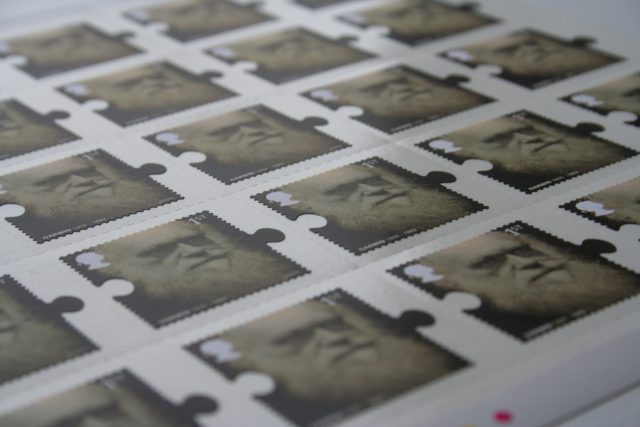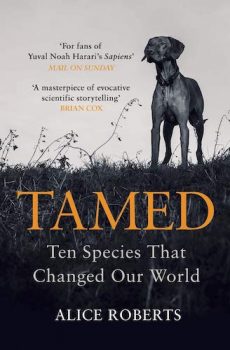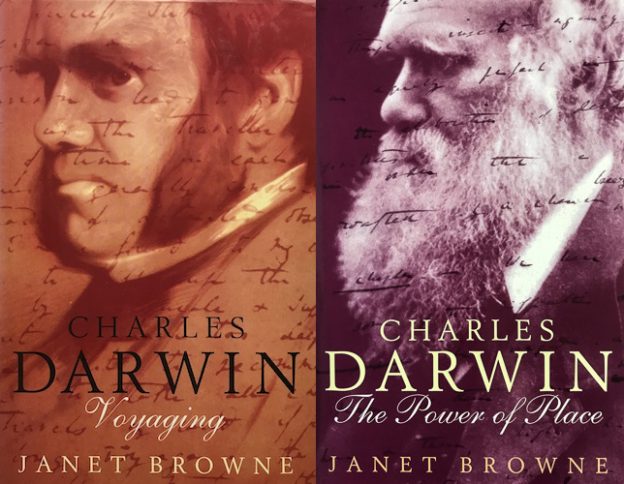12TH FEBRUARY 2021
Dear Friend of Darwin,
I hope you and your loved ones are keeping well in these difficult times.
Today marks Charles Darwin’s 212th birthday. Happy birthday, old chap!
Time flies. I find it hard to believe it’s 12 years since the Darwin bicentennial celebrations. Twelve years to the day since I stood in line at Hebden Bridge post office to buy the sheet of Darwin stamps that now graces my study wall. And 12 years to the day since I planted the tiny Darwin Bicentennial Oak sapling in the corner of our garden. That little tree is a lot taller now, although still a mere whippersnapper as far as oaks are concerned. It’s sad to reflect I’ll never see it reach its prime—if, indeed, it ever makes it that far. But it’s also comforting to realise that, long after we’re all gone, endless forms most beautiful and most wonderful will continue to grow, reproduce, and evolve.

Missing Links
Some Darwin- and evolution-related stories that caught my eye recently. These go all the way to eleven…
-
Charles Darwin’s notebooks reported stolen from Cambridge University
Library staff believed manuscripts were ‘mis-shelved’ in 2000, but now think theft likely. 🤬
See also: Charles Darwin: Notepads worth millions lost for 20 years
…I well remember remarking to a friend, at the Darwin bicentennial exhibition at London’s Natural History Museum in 2009, how it was unfortunate there was only a facsimile of Darwin’s most famous notebook on display, even though most of his other notebooks were there. Now we know why. -
Counting the species: how DNA barcoding is rewriting the book of life
We do not know how many species live on earth. Barcoding could change that—and open the way for incredible discoveries.
See also: Hundreds of new genomes help fill the bird ‘tree of life’ -
Butterfly dichromatism primarily evolved via Darwin’s, not Wallace’s, model
Sexual dimorphism is typically thought to result from sexual selection for elaborated male traits, as proposed by Darwin. However, natural selection could reduce expression of elaborated traits in females, as proposed by Alfred Russel Wallace. A new study considers these different explanations in the case of certain butterflies.
See also: Butterfly colour diversity due to female preferences -
Is this really Mary Anning at Lyme Regis? Or someone else somewhere else?
Michael Roberts makes a pretty convincing case that a portrait of the famous fossil collector Mary Anning is not at all what it seems. -
Chinese flower has evolved to be less visible to pickers
A flower used in traditional Chinese medicine seems to have turned grey to blend in with the surrounding rocks. -
Evidence backs Darwin’s theory about ‘runt’ flowers
Until now, no one had properly tested Darwin’s hypothesis on the link between bilateral symmetry and self-fertilisation in permanently closed flowers. -
Lockdown Embryology and Lockdown Anatomy (videos)
Anatomist, presenter, and author (see book recommendations below) Prof Alice Roberts has produced two excellent video series to entertain and educate us during lockdown. -
The wings of insects might have evolved from the legs of crustaceans
The first wings on earth might have evolved from the scuttling legs of an ancient, flightless crustacean.
See also: How the insect got its wings: scientists (at last!) tell the tale -
Spitting cobras may have evolved unique venom to defend from ancient humans
…a projectile defence being beneficial against attackers who keep their distance. -
Lend an ear to a classic tale of mammalian evolution
Fossil evidence enables a re-evaluation of how the middle ear evolved.
See also: Fossilised glider takes the origin of mammals back to the Triassic (video) -
True Facts: The Incredible Tardigrade (video)
The latest in Ze Frank’s silly, yet surprisingly educational videos. This one is on tardigrades, also known as ‘water bears’.
For regular links like these, please like and follow the Friends of Charles Darwin Facebook page.
Natural Selections
Some book recommendations for you:
Journal of Researches
Work on my ‘Darwin book’ continues its slow-but-steady progress. Having set myself the entirely arbitrary target of (at least) matching the word-count of my Moor book, my first draft could be said to be just over 90% of the way there—although experience has taught me you really shouldn’t measure progress on books in such a way.
Recently, I’ve been writing about oak trees and squirrels, and about how Darwin made species classification make sense. Monkeys are next on the agenda—although the way I tend to get sidetracked, I might well end up writing about something else entirely.
Expression of Emotions
Thanks for taking time to read this newsletter. Please feel free to forward it to any friends you think might like to subscribe.
I’m planning to review the format of these newsletters. If you have any comments or suggestions, please drop me a line.
See you next time!
Richard Carter, FCD
friendsofdarwin.com
richardcarter.com



